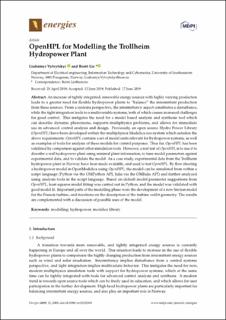| dc.description.abstract | An increase of tightly integrated, renewable energy sources with highly varying production leads to a greater need for flexible hydropower plants to “balance” the intermittent production from these sources. From a systems perspective, the intermittency aspect constitutes a disturbance, while the tight integration leads to a multivariable systems, both of which causes increased challenges for good control. This instigates the need for a model based analysis and synthesis tool which can describe dynamic phenomena, supports multiphysics problems, and allows for immediate use in advanced control analysis and design. Previously, an open source Hydro Power Library (OpenHPL) have been developed within the multiphysics Modelica eco-system which satisfies the above requirements: OpenHPL contains a set of model units relevant for hydropower systems, as well as examples of tools for analysis of these models for control purposes. Thus far, OpenHPL has been validated by comparison against other simulation tools. However, a real test of OpenHPL is to use it to describe a real hydropower plant using minimal plant information, to tune model parameters against experimental data, and to validate the model. As a case study, experimental data from the Trollheim hydropower plant in Norway have been made available, and used to test OpenHPL. By flow sheeting a hydropower model in OpenModelica using OpenHPL, the model can be simulated from within a script language (Python via the OMPython API, Julia via the OMJulia API) and further analyzed using analysis tools in the script language. Based on default model parameter suggestions from OpenHPL, least squares model fitting was carried out in Python, and the model was validated with good model fit. Important parts of the modelling phase were the development of a new friction model for the Francis turbine, and iterations on the description of the turbine outlet geometry. The results are complemented with a discussion of possible uses of the mode | en_US |

